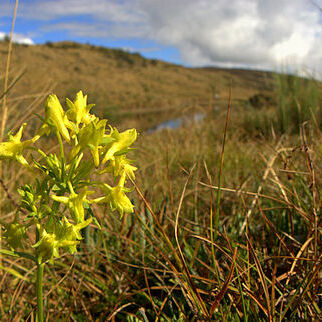Herbs, annual, biennial or perennial. Leaves sessile or petiolate, usually 3-5-veined, membranous to fleshy. Inflorescence terminal or axillary, subum-bellate, rarely a raceme or spicate cyme. Flowers with the calyx 4-parted, foli-aceous, the lobes linear, narrowly ovate, ovate or spathulate, usually papillate and bearing a small squamella at the base; corolla 4-parted, white, yellow, green or purple, campanulate, marcescent, the lobes dextrorsely convolute, elliptic to ovate, obtuse to acute, occasionally apiculate, entire to erose, often auriculate and papillate, prolonged at the base into usually short, retrorse spurs; stamens 4, included, adnate to the corolla tube, the filaments linear or ? dilated, the anthers ovate, oblong, or subtriangular, versatile; pistil included, the ovary sessile, the stigma bilobate. Fruit a compressed capsule, narrowly ovate to ovate, often subfalcate, septicidally dehiscent, surrounded by the marcescent calyx and corolla; seeds globose or ? flattened, brown to greenish tan, the testa granular or reticulate. Pollen grains in monads, radially symmetrical, isopolar, subprolate to prolate, the amb ? triangular, 40 X 28 microns, 3-colporate, the colpi relatively long with tapering ? acute ends, the colpus membrane smooth, ora rounded, relatively small, diameter of apocolpia 10 microns; exine 2 micons thick; sexine as thick as nexine, smooth or OL-pattern (H. woodsoniana).
More
Herbs annual [or perennial]. Roots slender, fibrous. Sometimes with elongated rhizomes. Leaves opposite [or whorled]. Inflorescences terminal and axillary, in clusters or sometimes in lax panicles of cymes. Terminal clusters umbel-like, subtended by a whorl of 4 leaves, often on short axillary branches. Flowers 4merous. Calyx lobed nearly to base. Corolla campanulate, lobed to below middle, with spurs near base of corolla tube. Stamens inserted on corolla tube. Ovary 1celled. Style very short. Stigma 2lobed. Capsules ovoid, 2valved, 1.1-1.3 cm, many seeded. Seeds ellipsoid to subglobose; seed coat almost smooth.
Fls 4-merous; cal-tube short, campanulate, with foliaceous lobes; cor (in ours) nearly tubular to somewhat narrowed distally, lobed to below the middle, prolonged at base (at least in some fls) into short, divergently retrorse spurs; stamens at the summit of the cor-tube, shorter than the lobes; ovary conic, gradually tapering to the short style; stigma 2-lobed; fr lanceolate, acute; herbs with opposite or basal lvs and small fls in cymose clusters terminating the stem and branches or forming a somewhat thyrsoid infl. 100, mainly New World.

